Going home
This is a story by Lennart Pearson, living in South Carolina. He and his mother went with M. S. GRIPSHOLM in 1946 from New York to Göteborg (Sweden) to visit their family.
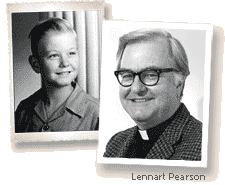
The author is an Episcopal priest of Swedish parentage who here recalls
crossing the Atlantic late in 1946. His mother, having emigrated
earlier, wanted to visit her aging father in Hannabad (near Markaryd).
When World War II ended and the Swedish-American Line resumed
transatlantic passenger service, she put her name on a long waiting
list for reservations. At last she was told she could have a cabin on
the M. S. GRIPSHOLM, sailing December 6th and arriving in Gothenburg
ten days later, just in time for Christmas.
These are some extracts
from his recollections of the trip.
The full article can be found in the journal - Swedish American Genealogist no 1 (2006)
By: Lennart Pearson, South Carolina, USA
The Ship
The Gripsholm, to my eyes was simply enormous. It was docked at
Pier 97, at the west end of 57th Street on the Hudson River. The pier
itself was a long, drafty shed in which several thousand people were
all trying to figure out what to do next. There was baggage everywhere.
Movable picket fences separated passengers according to whether they were
traveling First Class (blue tags), Cabin Class (green tags), or Tourist
Class (red tags).
Trunks and suitcases were to be checked in by last name.
The New York harbour
Outside, taxicab drivers were honking their horns, porters with
hand trucks were hustling newcomers, and food vendors were hawking
their indigestibles. Inside the shed, policemen helped new arrivals
make sense of the signs while people were shouting in various languages
across wooden barricades.
Parents were tugging at cranky children,teenagers were staring at each
other,
officials were stamping anything handed them, representatives from travel
agencies were selling tickets, and wispy old ladies in hats and gloves were
clutching their handbags,protecting them from pickpockets and thieves.
Beyond the noise, I could see through the open walls the portholes of the
gleaming white ocean liner--and the gangplanks leading into the ship.
Several from church had come down to the dock to say goodbye. We
were all dressed up in our Sunday best. I even had a hat with a brim
that I wore somewhat reluctantly.
At 12.30 p.m., thirty minutes before the Gripsholm was due to
depart, the ship*s horn signaled that all visitors were to leave.
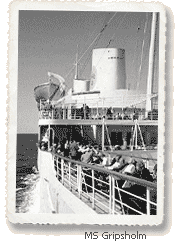
At the boat - leaving the harbour
It was an unforgettable sound, ear-shatteringly magnificent as it echoed
back from the New Jersey side of the Hudson River. Parting was hard.
When I said goodbye to my father, I couldn´t imagine that it was
tougher for him than for me. (It always seems harder for those left
behind.)
In those days it was a custom to throw rolls of narrow
streamers from the ship to the dock. The thin strip of paper was the
last link broken as the ship was slowly nudged from the dock by the
attending tugboats. The ship began to move--very, very slowly--backing
out into the Hudson River. The figures on the pier grew smaller and
smaller until they were no longer identifiable.
As the tugs withdrew and the ships own screws began to turn, a faint
vibration indicated
that the ship was moving under its own power.
On board
I remained on the upper deck until 2.30 p.m., by which time the Gripsholm
had passed the Statue
of Liberty and Ellis Island and was well outside the harbor. At
lunch, the table steward brought out a variety of dishes, many of which
I knew from home: cheese, herring, and lingonberries.
Scandinavian cuisine--Swedish, Norwegian, Danish cooking--is unique.
Not everyone likes smoked eel, cheese made from goat´s milk, head cheese, or
lutfisk
(boiled stockfish previously soaked in lye), but nearly everyone can
find something tasty on the table, especially when the meal is followed
by real coffee, Danish butter cookies or a slice of raspberry creamcake.
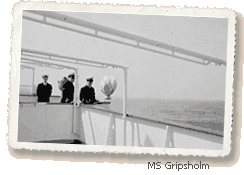
Later in the afternoon, there was a lifeboat drill. We were
each assigned to a particular lifeboat, which meant that when the alarm
sounded, everyone gathered at designated points on one of the upper
decks. Our particular cabin was on D-deck, which was about at the
waterline. There were two decks further down, E-deck and F-decks.
The cabin was tiny, with barely enough room to turn around. My thought was
to spend as many waking hours as possible outside the cabin. On a wall
in one of the corridors, there was a map where one could see how far
the ship had traveled the previous day, usually 30-40 Swedish miles.
Next to the map was a posting of world news as it had been received in
the ships radio room during the night, together with a listing of
the day´s activities. For example, on Sunday morning those who wished
to do so, could participate in the church service held in the
first-class reading room. The service was conducted by the ship´s
captain himself, who. read the "Order for Morning Prayer" of the Church
of Sweden. Hymns were accompanied by a small portable organ.
|
Special events on board
Sunday dinner was especially nice. It was a buffet table with
all kinds of delicacies. On the menu, there was also a daily
instruction about the six-hour time adjustment that we needed to make
as the ship traveled east. Each day, we were to advance our clocks a
modest twenty or thirty minutes so that we would arrive on local time.
After breakfast, passengers could rent a deck chair and a blanket for
relaxing and taking in the salty sea air.
Those who were more energetic played shuffleboard or ping-pong.
Seasick
Some passengers, including my mother, suffered from seasickness,
an unpleasant feeling that arises when what you see with your eyes
doesn´t match the motion that you feel.
By the middle of the week, the weather became stormier and some parts
of the deck had to be closed. My mother stayed in the cabin for
several says. The food didn´t taste as good as it had at first, but I
didn´t miss any meals and I felt quite independent as I sat at the
table by myself.
Later in the week, I could make out the rocky coast of northern Scotland off
to starboard,
and on the map beside the elevator, I could see that we had passed to the
north of Great Britain.
It is said that seasickness ceases when you can see land, so my mother
was back among the living, but only temporarily because the North Sea
in December is known for its roughness.
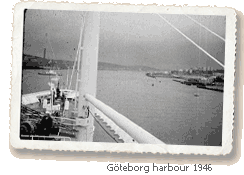 Arriving to Gothenburg Arriving to Gothenburg
On Monday morning, I was up early. The Swedish equivalent of
New York´s Ambrose Lightship was Vinga Fyr, a very old lighthouse that
marks the entrance to the archipelago of Gothenburg.
Once past Vinga Fyr, the ship took on its harbor pilot and continued to sail
slowly up
the well-marked channel toward the city. There were many small, rocky
islands and sometimes we could see people standing outside waving at
the ship.
|
Amerikaskjulet
At midmorning, we entered the river (Götaälven) on which
Gothenburg is situated. To the left I could see a large shipyard,
Gotaverken with huge cranes and gantries, vessels in dry-dock for
repair, and ships at various stages of construction, as well as the
usual tug and barge traffic found in a major seaport.
Presently I caught sight of ?Amerikaskjulet,? the arrival hall where we
would
disembark. The building was decorated with flags and banners, and on
top of the pier, at about 25 meter intervals, a number of yellow and
blue Swedish flags were waving beautifully in a brisk wind. Below a
large crowd was waiting for the 1,350 passengers to disembark.
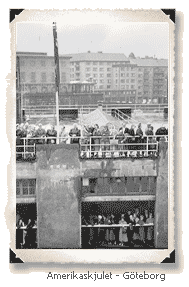
While the ship was secured by noon, it would be another several
hours before we could leave the ship because first class and cabin
class passengers were given preference. From the upper deck I could see
the booms hoisting luggage and mailsacks in big nets up from the holds
of the ship. After passing through one of the lounges where the
authorities checked our papers and our passports, the moment finally
arrived.
We passed slowly down the gangplank and I was in Sweden!
In New York, the dock was situated perpendicular to the street; in
Gothenburg it was parallel to the street. Otherwise, Amerikaskjulet
looked much the same as the pier in New York, though it seemed to be
better organized. When we had assembled our luggage, we collared a
customs inspector. He asked a few questions, slapped tags on our bags
and sent us out through the gates on to the street?
On my way to my relativies
Eventually, we got to the central railroad station. It was a
new and exciting experience. Freight cars seemed to be unusually
short and stubby. Passenger trains had signs on each individual coach
indicating its final destination. When the train arrived at Markaryd,
we were met at the station by my Uncle Andrew and my cousin, Allan, who
was ten years old. The five-kilometer ride by taxi out to Hannabad was
memorable. It was totally dark, and there was about 40cm of snow on
the ground. When the village of Markaryd disappeared behind us, I
could only see what was illuminated by the headlights of the car.
The unpaved, snow-covered road was barely visible, though the driver seemed
to know every curve and turn. We rode uphill and downhill, over little
bridges, and through a deep, deep forest with enormous spruce trees
whose snow-laden branches seemed to bow in a deep salute.
The reunion was emotional. Tears flowed freely, and everyone
was talking at the same time. My mother was very, very happy.
|
|
 |
We would like to thank the author Lennart Pearson and the Swedish American Genealogist for letting us publish this article on our website.
Photos: Lennart Pearson, South Carolina, USA
Source: Swedish American Genealogist no 1 (2006) |
|








